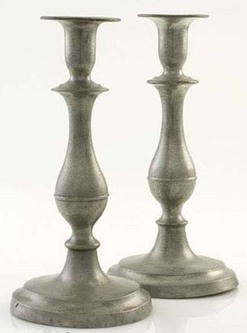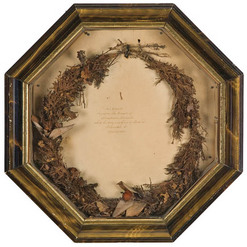 In the mid-19th century, Cincinnati was booming and production of all kinds of goods increased rapidly, as the city’s industries found themselves well positioned to be supplying the frontier. Utilitarian wares such as pewter were in great demand, and in 1847, Prussian-born Henry Homan (1826-1865) and English-born potter Asa Flagg (1813-1854) began a partnership manufacturing pewter.
In the mid-19th century, Cincinnati was booming and production of all kinds of goods increased rapidly, as the city’s industries found themselves well positioned to be supplying the frontier. Utilitarian wares such as pewter were in great demand, and in 1847, Prussian-born Henry Homan (1826-1865) and English-born potter Asa Flagg (1813-1854) began a partnership manufacturing pewter.
Despite the short nature of the partnership (Flagg moved on in 1851), the company produced a prodigious amount of traditional pewter from utilitarian wares like candlesticks and coffee and tea services to ecclesiastical items like chalices, baptismal bowls and alms dishes. They are perhaps best known for their baluster-form candlesticks which are instantly recognizable and which were manufactured in a variety of sizes, from 4.5” to 14” in height, with larger sets for ecclesiastical use. (Early pieces were mostly unmarked, but occasionally they appear with “Flagg & Homan” imprinted in an oval mark.) Between the access to markets provided by the Ohio River trade and a candle mold machine that they patented, Homan and Company (Henry Homan died in 1865) continued to grow rapidly and by 1888, the business occupied a full block of East 7th Street in Cincinnati and ran two shifts with one hundred employees.
By the turn of the twentieth century, the company, which would become Homan Manufacturing Company, had refocused production to sell silver-plated wares for a time, but ultimately would experience a revival in the 1930s, manufacturing coffee and tea services, pitchers, trays, and even their classic candlesticks, again in a variety of sizes, in their traditional style (marketed as “made as it was over 80 years ago”) while marking them “Flagg & Homan Pewter.” This mark makes the later versions easy to distinguish, along with the fact that the candlesticks do not have the push-up candle ejector that the originals have. Homan Manufacturing Company would remain in operation until 1941.
Because their candlesticks have become iconic pieces and because they are earlier than most other extant pieces, they tend to be much more popular with collectors, although Flagg and Homan is still a rather regionally focused market. Non-candlestick forms can typically bring $200-500, but candlesticks, depending on size and condition, can bring as much as $1,000 or more. The smallest sizes and those rare pairs with engraved decoration tend to be the most desirable.



![Redware; Bell (Samuel), Shenandoah Valley, Figures (2), Dogs, Whippets, Recumbent, Paint Decoration, 10 inch. A very rare and important pair of Shenandoah Valley redware [dog figures depicting] whippets, both signed Samuel Bell / Winchester Sept 21 1841, Winchester, Virginia origin, matched pair of molded redware whippet figures with incised details to face and paws, both dogs painted black with white-and-red eyes and red mouths, reclining atop green-painted bases with incised borders.](http://www.prices4antiques.com/item_images/medium/68/38/94-01.jpg)



